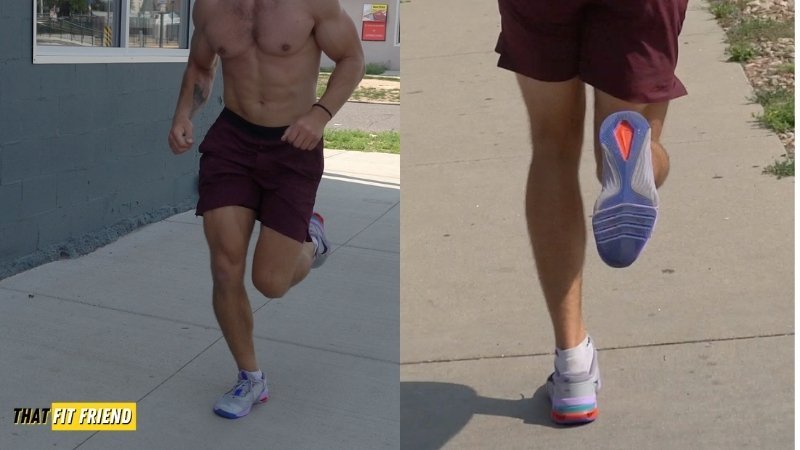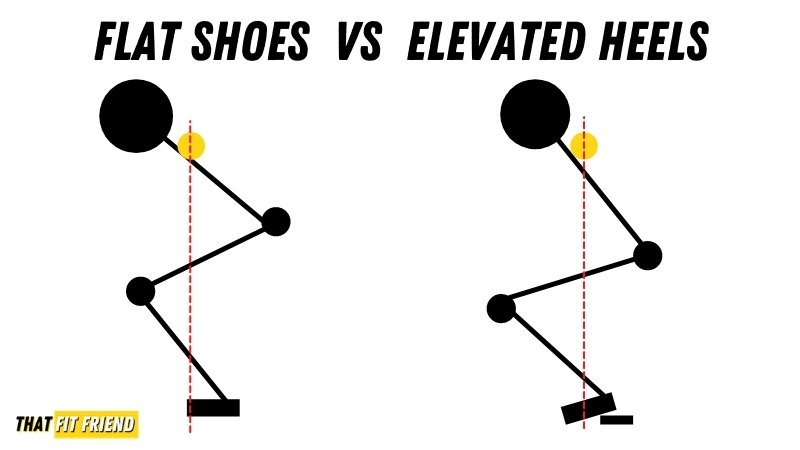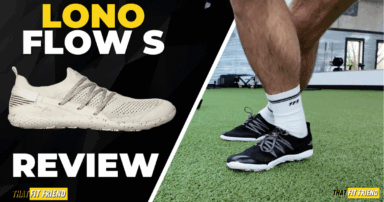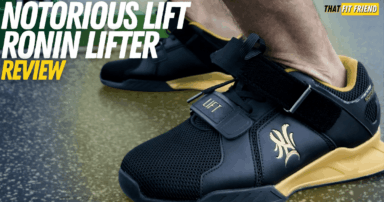The Nike Metcon cross-training shoe line has been a top performer in the CrossFit and cross-training scenes since its debut in 2015. Every year, countless lifters and athletes consider making the switch to Nike Metcons as their primary training shoes.
This switch is then typically followed by ample research and countless Nike Metcon questions. Questions like, what are Nike Metcons good for, and which Nike Metcon is best for certain activities like CrossFit are incredibly common asks.
It’s crazy realizing that we’re already at the Metcon 9. This shoe line has changed so much over the last decade, and it’s wild to see the growth of the Metcon’s popularity and how it has transcended outside of niche training contexts.
Table of Contents+
On the market for new cross-training shoes? Make sure you check out the TF2 Cross-Training Shoe Calculator to be matched with the best shoes that I’ve reviewed for your training needs!
What Is a Nike Metcon Shoe?
Nike Metcon is a shoe line from Nike specifically tailored towards cross-training and CrossFit. Since the original Nike Metcon debuted in 2015, Nike has made it a core cross-training shoe line for their company and has created spin-off Nike Metcon models to provide a wider range of lifters and athletes with this style of shoe.
For example, we have training shoe lines like the Nike Free Metcon, Nike React Metcon Turbo, and Nike Metcon Sport to name a few. These shoe lines all have “Nike Metcon” in their name because they provide a similar core ideology and construction as the main Nike Metcon shoe line.
Metcon stands for metabolic conditioning, which is a type of workout that includes a wide range of activities that are geared towards improving one’s strength and cardio with both anaerobic and aerobic exercises.
That being said when you see Nike training shoes that have “Metcon” in their name, then you can assume that the shoe you’re looking at will be good for a wide range of tasks.
So, while the original Nike Metcon line is best served for more serious cross-training and CrossFit, the spin-off Nike Metcon models mentioned above are designed to tackle different sub-categories of cross-training.
For additional context and for more examples, the Nike Metcon Sport is designed to be a budget-friendly less serious cross-training shoe, while the Nike Free Metcon shoes are intended to be cross-training shoes best used for classes and HIIT.
What Are Nike Metcon Shoes Good For?
Nike Metcon shoes are good for a wide range of activities and each Nike Metcon model will be better than others for certain styles of training.
For this Nike Metcon guide, we’re going to look at the three core Nike Metcon training shoe categories, including the original Nike Metcon training shoe line, the Nike Free Metcon line, and Nike Metcon Sport.
- Nike Metcon: Best for CrossFit, heavy lifting, more serious cross-training, some classes, and HIIT.
- Nike Free Metcon: Best for classes, HIIT, athletic-focused training, and recreational lifting.
- Nike React Metcon Turbo: Best for lifting, classes, HIIT, and athletic-focused training.
- Nike Metcon Sport: Best for budget-friendly shoppers, casual cross-training, classes, and recreational lifting.
Note, I didn’t include the Nike Metcon Sport in the graphic above. If they were presented with visuals similar to the other models, then they would be sub-par for lifting and CrossFit and an okay model for tackling classes.
If you have additional questions about any of the Nike Metcon training shoes, drop a comment below or reach out to me personally and I can help you decide which model would be best for the context of your needs.
Why Are Nike Metcon Shoes Good?
Nike Metcon shoes are good because they can excel in a variety of training settings, provide adequate stability for lifting and grounding the feet, and have decent levels of responsiveness for more versatile training.
It’s important to note that when you’re looking at Nike Metcon shoes that their best uses and what they’re good for will always scale per the model in question and your style of training. For example, the Nike Metcon 6 and Nike Metcon 7 will be good cross-training shoes for tackling serious CrossFit workouts but will fall short for classes since they lack high levels of responsiveness.
Conversely, the Nike Free Metcon 4 and Nike React Metcon turbo models will provide a nice level of maneuverability and responsiveness, but they will lack key construction features to help them excel in CrossFit settings.
That being said, Nike Metcon shoes are good for providing high levels of stability, versatility, and durability, and their best uses will be dependent on the model you’re looking at and the style of training you want to accomplish in them.
Where to Buy Nike Metcon Shoes?
If you’re interested in buying Nike Metcon shoes, then you have a wide range of outlets to explore and look into. Unlike some cross-training shoes, Nike Metcons can typically be pretty easy to find in person at major shoe stores and sports apparel retail outlets.
Below is a list of popular places, both online and in-person, to buy and purchase Nike Metcon shoes. If you’re going to or want to try on Nike Metcons in-store, then I would highly suggest calling the store first to ensure they have the model in stock that you’re after.
Far too many times, I’ve driven to something like a Nike store only to find that they don’t carry the model I was going to purchase.
Where to Buy Nike Metcon Shoes In-Store
- Nike Outlets/Stores
- Dick’s Sporting Goods
- Foot Locker
- Finish Line
Outside of these, your local sporting goods store may also have Nike Metcon models, and this list is far from definitive. It would be impossible for me to nail every single retail outlet worldwide that carries Nike Metcons.
However, these are a few of my favorite reliable spots for finding Nike Metcon training shoes.
Where to Buy Nike Metcon Shoes Online
- Nike
- Dick’s Sporting Goods
- Rogue Fitness
- WIT Fitness
- Road Runner Sports
- Fleet Feet
- Amazon
Again, these are some of my go-to’s and are fairly consistent regarding having stock in various Nike Metcon shoes. If you’re like me, then you likely want to save money, so I’d suggest shopping around through the list provided above to find the best deals possible on the Nike Metcons you’re after.
How Should Nike Metcon Shoes Fit?
Nike Metcon fit and sizing can be really interesting because the lasts (molds) that Nike uses in their Metcon models don’t always align with every lifter and athlete’s foot.
That being said, I have a general rule of thumb that I use when fitting Nike Metcon shoes and most cross-training shoes. That rule of thumb is to ensure you have at least .2″-.6″ of room in the toe box when sizing your cross-training shoes.
Below are some of my sizing and fit thoughts for a few of the most recent Nike Metcon models.
- Nike Metcon 5: True-to-Size, but more narrow last. Not a great option for wider feet.
- Nike Metcon 6: True-to-Size, but more narrow last. Not a great option for wider feet.
- Nike Metcon 7: True-to-Size, but more narrow last. Not a great option for wider feet.
- Nike Free Metcon 4: True-to-Size, but fits more narrow with a very shallow in-step.
- Nike React Metcon Turbo: True-to-Size.
- Nike Metcon Sport: True-to-Size
With Nike Metcons specifically, they typically run a bit more narrow so wider-footed athletes will often find them rather uncomfortable. Additionally, Nike Metcons also have low-profile boots which can leave them prone to having heel slip for certain athletes and contexts.
Generally though, if you size your cross-training shoes correctly per the range suggested above, then you shouldn’t experience heel slip issues in the latest Nike Metcon models. The infamous Nike Metcon heel slip issues were more present in older Nike Metcon models.
Now, that doesn’t mean heel slip is completely non-existent in newer Nike Metcon shoes, and there are some athletes who may never find Nike Metcon comfortable or that they stay on their feet really well, but as a whole, this issue is a lot better in NikeMetcons than ever before.
How to Clean Nike Metcon Shoes
One of the easiest ways to make your Nike Metcon shoes go the distance is to clean them fairly regularly. This helps prevent dirt and dust build-up which can break down shoe materials like foams and polyurethanes at faster rates.
Even if you’re not training outside regularly or wearing your Nike Metcons as daily drivers, it’s a good idea to give your shoes some love every couple of months. The best part is that you don’t need to sink tons of time cleaning your Nike Metcons. A simple 5-10 cleaning sessions every few months will do the trick.
To clean your Nike Metcon shoes, we’re going to use a spot clean technique. Do NOT put your Nike Metcon training shoes in the washer and dryer as this will cause them to break down at a much faster rate.
How to Properly Clean Your Nike Metcon Training Shoes
Below is a quick rundown of how to properly clean your Nike Metcon training shoes, and all other cross-training shoes, for that matter.
What You’ll Need
- Soft Soap (go odorless and clear if possible)
- Two Washcloths
- Lukewarm Water
What To Do Next
- Get a washcloth a little damp with lukewarm water and place less than a dime size of soap on the damp washcloth.
- Inspect your Nike Metcons and hand spot clean areas that are accumulating a lot of dirt, dust, and grime. Generally, this will be around the outsole and midsole.
- Once you’ve wiped down your shoes, use the dry washcloth to dab over noticeably wet areas.
- After you’ve repeated this for both models, take out the insoles and set your shoes in a dry environment. By a vent inside your home is a really good option for this context.
If you follow these steps every couple of months, then your shoes should last a few months longer due to less cumulative breakdown. Granted, this is barring noticeable rips or tears to the shoe’s construction.
What Are Nike Metcon Inserts For?
The Nike Metcon 5 and Nike Metcon 6 were the first two Nike Metcon cross-training shoes to come with additional Nike Hyperlift inserts. These Hyperlift Inserts were essentially pieces of plastic that you would place into your Nike Metcons to bring their heel height up an additional 8mm.
Traditionally, a Nike Metcon’s heel-to-toe drop sits at 4mm, but with the insert, you would be training on a 12mm heel-to-toe drop. Now, how does this relate to training, and what are the Nike Metcon inserts for?
The Hyperlift inserts were intended to turn your Nike Metcon cross-training shoe into pseudo-weightlifting shoes. Weightlifting shoes come with heel heights that range from 16-25mm, so while a height of 12mm is a bit smaller than a traditional weightlifting shoe heel height it will provide some of the benefits of working with a greater heel-to-toe drop.
In the context of training, an elevated heel will put your foot into a plantarflexed position which will then provide you with a better means of achieving different dorsiflexion ranges of motion while training. If your ankle mobility ever feels limited when working out, then an elevated heel can put your ankles into better environments of achieving various degrees of dorsiflexion.
Coaching Terminologies
- Plantar Flexion: The act of pressing the foot into the ground, think of pressing on a gas pedal.
- Dorsiflexion: The act of flexing the foot upwards, think bringing your toes to the sky.
This in return will often then result in more favorable lifting mechanics due to the elevated heel better allowing athletes to maintain their balance, a more upright torso position, and maintain loading over the midfoot.
In short, the Nike Hyperlift insert is designed to provide a greater range of uses for the Nike Metcon and to better assist lifting mechanics when a heel wedge is desired.
How Are Nike Metcon Shoes for Running?
Nike Metcon shoes are not going to be your best shoes for running whatsoever. Each Nike Metcon model will vary in its running performance and this variance will reciprocate with each shoe’s stability.
Generally speaking, if cross-training shoes are highly stable in nature, then they will not be the best for running especially when running longer distances. This is why I’d highly recommend not running longer distances in models like the Nike Metcon 5, Nike Metcon 6, and Nike Metcon 7.

These Nike Metcon shoes are designed specifically for CrossFit and serious cross-training so their running performance will lack due to having less responsiveness. That being said, if you’re wearing core Nike Metcon shoes like the Nike Metcon 1-7, then you’ll want to keep your running limited to short distances or distances that are programmed in WODs.
For the Nike Free Metcon, Nike Metcon Sport, and Nike React Metcon Turbo, their running will vary even more as these models are all a bit more responsive than the more CrossFit-focused Nike Metcons. Below are some of my running thoughts for some of the latest Nike Metcon spinoff models.
- Nike Free Metcon 4: 0-2 miles per running session.
- Nike React Metcon Turbo: 0-1 mile per running session.
- Nike Metcon Sport: 0-2 miles per running session.
If you’re planning on tackling longer runs, then I’d highly suggest finding a good pair of running shoes that accommodate your running style and anatomy. This will give you a better ride for your needs a limit how beat up you feel after runs and workouts.
Frequently Asked Questions (FAQ)
Q:What is Nike Metcon?
Q:Which Nike Metcon is best?
Q:What are Nike Metcon shoes good for?
Takeaway Thoughts
The Nike Metcon training shoe line continues to evolve and grow. What started as the original Nike Metcon designed for CrossFit and cross-training has since grown into a product line with multiple sub-categories.
Now in its seventh iteration, the core Nike Metcon cross-training shoe has seen a wide range of changes, tweaks, and alterations to its core construction.
If you’re interested in any of the Nike Metcon cross-training shoes and you’re uncertain which model to go with, drop a comment below or reach out to me personally via Instagram (@that_fit_friend or @jake_boly).















Adam
Hey Jake,
Any recommendations on a replacement for the Metcon Sport? I tried switching to the Metcon 5 a couple years ago but they were too narrow. I bought an extra pair of the Sports when they were discontinued but my last pair is looking rough.
Hey Adam! That’s a tough one. The UA TriBase Reign 4 could be a good substitute and you could also explore the Reebok Nano X2. Metcon 8 may work, but I’d def suggest trying them on in-store before buying to see if you notice a big width/last difference from the Sport. I wish I still had a Metcon Sport to compare first person for ya!
Blaine Anderson Jr
Hey Jake,
I have a question about sizing. I am looking to get a pair of Metcon 5s but don’t know what size to get and I can’t try them on as they are no longer in store. I own a pair of Metcon 1 & 2, both size 11. I have been looking at other reviews, some say size-up and other say true to size. Thoughts?
Hey Blaine — IMO, if the Metcon 1 + 2 fit well with your size 11, then I’d say go true-to-size. IMO, I think a lot of folks recommend sizing up when they’re not used to how narrow Metcons can run, but since you’re used to their fit — I think you’d be safe going true! Keep me posted!
Blaine Anderson Jr
Jake, finally got a pair of Metcon 5s in size 11. They fit tighter around the my foot than the 1s and 2s, which I think makes them better. Thanks for input and recommendations.
Mike Rachmiel
Hey jake,
Question on your metcon 6 shoes, do you use the upper eye hole for lacing? I purchased a pair in this past october for a great price $80 through dicksporting goods. Anyway i use the upper eye hole becuase the laces are horrible and keep coming undone. Just noticed that the laces torn through the upper eye hole and possible may tear through the side seam. Just a poor design by Nike shouldve had a plastic insert. I also have metcon 4 and have no issues.
Any suggestions ?
Hey Mike — Yeah, the low-profile design with the laces that extend all the way up can certainly be problematic. I do use that top lace, but it’s not a must especially if you don’t notice heel slip when not lacing all the way up. In my Nano X, I don’t use their top lace and I’d say that’s somewhat of a similar scenario as this. I think the best call here would be to test it out to see if you have any heel slip issues. If you don’t, then you should be fine skipping that top eyelet! You could also try some lace-locking methods with that top eyelet (I have an article on heel slip) and that may take pressure off it and prevent it from ripping while also giving you a secure fit!